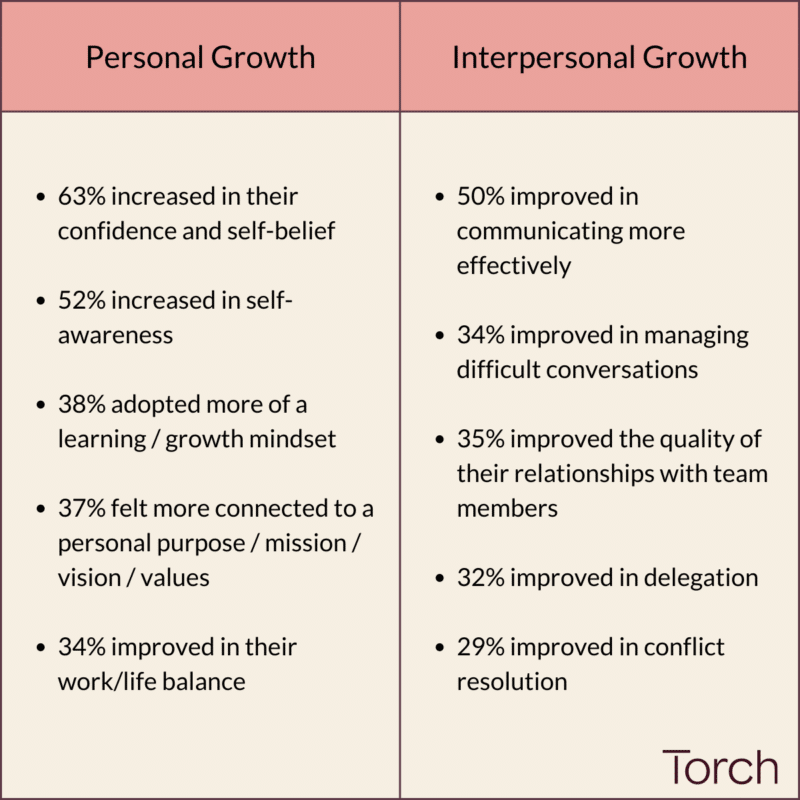What, or who, has had the greatest influence on who you are as a leader? How about the greatest influence on your ability to learn and grow at work?
If you’re like most people, you probably won’t cite that one-day leadership training you attended three years ago, or the online course you took. It’s more likely that the thing that has had the greatest impact on your behavior as a leader isn’t a thing at all, but a person–a coach, a mentor, a trusted manager.
This is borne out not just on a micro-level, but a macro one.
Leadership Training Doesn’t Drive The Expected Results
According to recent research conducted by Harvard Business Review Analytics Services, sponsored by Torch, leadership skills training is the most commonly used development method among the 665 organizational leaders surveyed. But only 35% of respondents rate skills training as extremely or very effective to achieving their desired results, compared to 60% for coaching.
The authors of this Harvard Business Review piece sum up the situation many organizations find themselves in: “Corporations are victims of the great training robbery,” they write. “American companies spend enormous amounts of money on employee training and education…but they are not getting a good return on their investment. For the most part, the learning doesn’t lead to better organizational performance, because people soon revert to their old ways of doing things.”
Fortunately, there’s a better way–one that improves organizational performance and makes people more likely to change their behavior. But before we get to the solution, it’s crucial to better understand the problem that this gap reveals: Why do organizations keep investing in training, if it’s widely acknowledged to be ineffective?
One contributor is our struggle to make decisions with long-term outcomes in mind. Most humans are programmed with present bias, or a tendency to choose a small gain in the present versus a larger reward in the future. A simple example of this is the decision to press snooze in the morning instead of going for a jog. You may get a few extra minutes of sleep, but that may not help you achieve your long-term fitness goals. Another contributor is something called status quo bias, which is our tendency to want to maintain what we have going, rather than opting for what can feel like a disruptive change. And finally, there’s the bandwagon effect, or our tendency to do something because we think others in our network are doing them, too.
For many organizational leaders, training offers all of these things: the promise of short-term gains, the ease of sticking to the status quo, and the feeling that you are following the path of other smart people. If your organization has always done leadership training, it doesn’t take any extra work to get buy-in to do it, so it might seem like you’re saving time (and it may feel right, because it’s the way you’ve always done things). It’s a scaled solution that appears to work while it’s happening or even in the few days after a great training session. It’s easy to think that it’s probably the right thing to do if everyone else is doing it.
The problem is that even the best training sessions aren’t designed to do what most organizations want them to do: enable leaders to learn, grow and sustainably change their behaviors. For one thing, virtual trainings or classes have anemic completion rates – generally between 5-15% – and even if they are completed, most participants forget about 75% of what they learn within six days.
The Science Behind Coaching Effectiveness
Coaching, on the other hand, is a research-backed method for changing behavior – at the individual, team and organizational levels. We’ve found from our data at Torch that 100% of coaching participants changed in at least one way from their engagement, with the average participant changing in eight ways in the following categories:

Some of these changes can even predict whether someone stays at the organization or moves up: 94% of coaching participants changed in at least one way related to retention, and 89% changed in at least one way related to promotion. And when individuals are coached, their teams benefit. Research shows that direct reports of coached managers are more likely to be satisfied at work, stay, and commit to their organizations. At the organizational level, the International Coaching Federation has linked coaching to higher performance, higher retention, and higher engagement.
What makes coaching more effective than training? It boils down to three key characteristics:
Leadership training has its place in an L&D strategy. But for organizations who want to see sustained behavior changes and a return on their investments, there’s another, and more effective, way to get there: investing in powerful relationships with coaches that have a ripple effect on organizational culture, engagement and performance.

